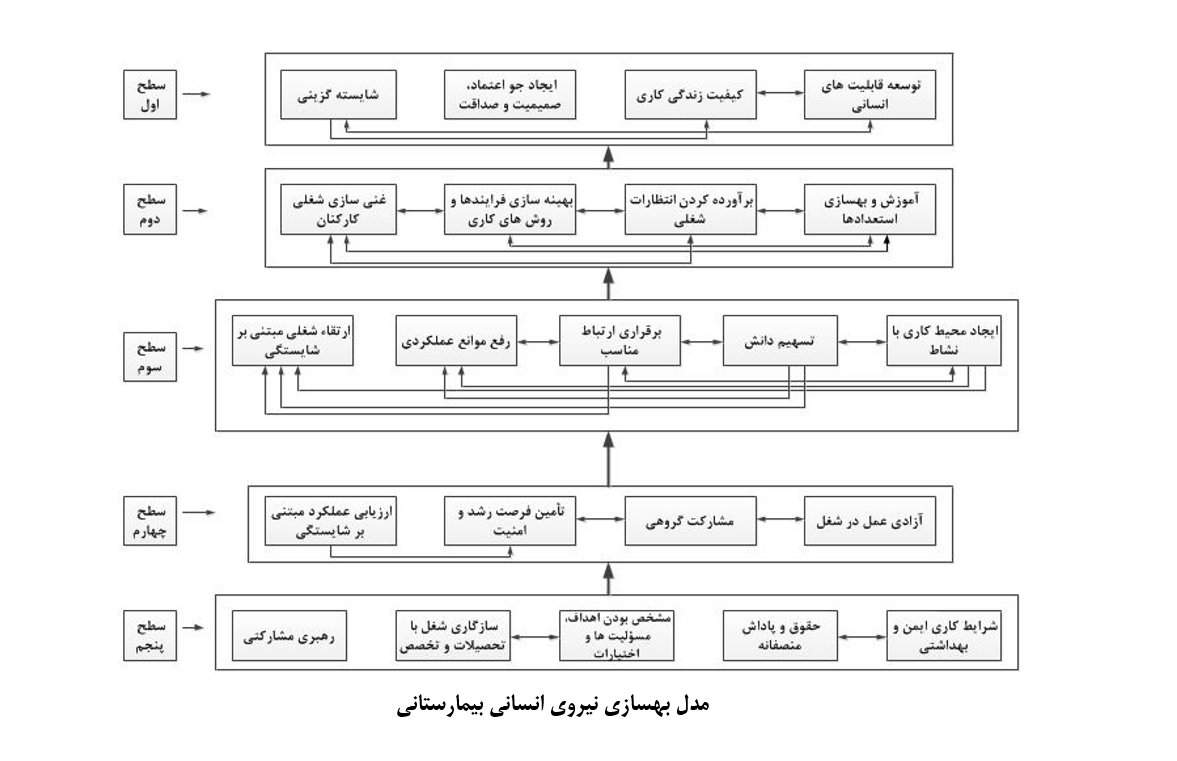Designing a Model of Factors Influencing Human Resource Development with an Interpretive Structural Approach (Case Study: Hospitals of Lorestan Province)
Keywords:
Resources, Human, Improvement , Resources , Human , Structural , InterpretativeAbstract
The present study aims to design a human resource development model in the hospitals of Lorestan Province. The research method is descriptive-survey. In terms of data type, the study adopts a mixed-methods approach. Qualitative and quantitative data were collected through library and field research. The statistical population consisted of 18 experts and academic specialists, who were selected using the snowball sampling method based on the principle of theoretical saturation. The research tool was semi-structured interviews, whose validity and reliability were confirmed. Qualitative data analysis was conducted using content analysis and coding through MAXQDA software, while quantitative data analysis was performed using interpretive structural modeling and MATLAB software. The research findings were presented in the form of a human resource development model for hospitals in Lorestan Province, structured into five levels. The executive recommendations for the hospital staff development system include redesigning internship processes in response to evolving needs and rapid technological changes, restructuring assessment and learning mechanisms to institutionalize an evaluation culture, redesigning the performance evaluation system, salary and reward systems, enhancing organizational commitment, and establishing processes to align individual and organizational goals.
Downloads
References
Boselie PAM, Veld J, Harten Van J. Management public on review management resource. Management Public and Research Administration. 2021;23(4):483-500. doi: 10.1080/14719037.2019.1695880.
Zainol NU, Kowang TO, Hee OC, Fei GC, Kadir BB. Managing Organizational Change through Effective Leadership: A review from Literature. International Journal of Academic Research in Business and Social Sciences. 2021;11(1):1-10. doi: 10.6007/IJARBSS/v11-i1/8370.
Ahmadi O, Kamalian A-R, Yaqoubi N, Ghasemi M, Jalali SS. Designing a model for improving the performance of employees in the Ministry of Interior with the foundation's data approach. Scientific-Research Quarterly of Resource Management in the Police Force. 2017;9(16):101-14.
Moqrab Elahi M, Jafari M. Explaining the methods of training employees based on the approach of training and improving human resources. Specialized Quarterly Journal of Government Managers' Thought. 2022;4(13):20-.
Mossadeq-Rad AM, Esfahani P, Afshari M. Strategies to increase the efficiency of Iranian hospitals: a regional review. Journal of Jihad University Health Sciences Research School. 2017;18(1):7-21.
Apornak A, Raissi S, Keramati A, Khalili-Damghani K. Optimizing human resource cost of an emergency hospital using multi-objective Bat algorithm. International Journal of Healthcare Management. 2021;14(3):873-9. doi: 10.1080/20479700.2019.1707415.
Kishvari M, Shirdel A, Taheri Mirquaid M, Yousefi A. Challenges of optimal human resource management in hospitals: a qualitative study. Journal: Qualitative Research in Health Sciences. 2017;7(4):349-60.
Ibukun T, Pérotin V. Employee empowerment, equality plans and job satisfaction: an empirical analysis of the demand-control model. Journal of Participation and Employee Ownership. 2023. doi: 10.1108/JPEO-10-2022-0014.
Ahuja V, Yang J, Shankar R. Study of ICT adoption for building project management in the Indian construction industry. Automation in Construction. 2009;18(4):415-23. doi: 10.1016/j.autcon.2008.10.009.
Okochi K, Ateke BW. Employee empowerment: A strategy for optimizing employee performance. Nigerian Journal of Business and Social Review. 2020;11(2):125-37.
Aguinis H, Beltran JR, Cope A. How to use generative AI as a human resource management assistant. Organizational Dynamics. 2024;53(1):101029. doi: 10.1016/j.orgdyn.2024.101029.
Doldi A, Mozesi A, Gurji MB. Designing a human resources improvement model based on cloud computing (case study: Tejarat Bank). Science and Techniques of Information Management. 2023. doi: 10.22091/stim.2023.9683.1980.
Jalali L, Jafari M. The mediating role of human resource improvement in the relationship between knowledge management and teachers' job performance. Education Management and Perspectives Quarterly. 2022;4(3):1-17.
Sunahwati ES, Maarif MSA. Human Resources Development Policy as a Strategy for Improving Public Organizational Performance. JKAP (Jurnal Kebijakan dan Administrasi Publik). 2019;23(1):50-62. doi: 10.22146/jkap.37957.

Downloads
Published
Submitted
Revised
Accepted
Issue
Section
License
Copyright (c) 2025 محمد فرید (نویسنده); بتول فقیه آرام (نویسنده مسئول); محسن عارف نژاد, ناهید شفیعی (نویسنده)

This work is licensed under a Creative Commons Attribution-NonCommercial 4.0 International License.










